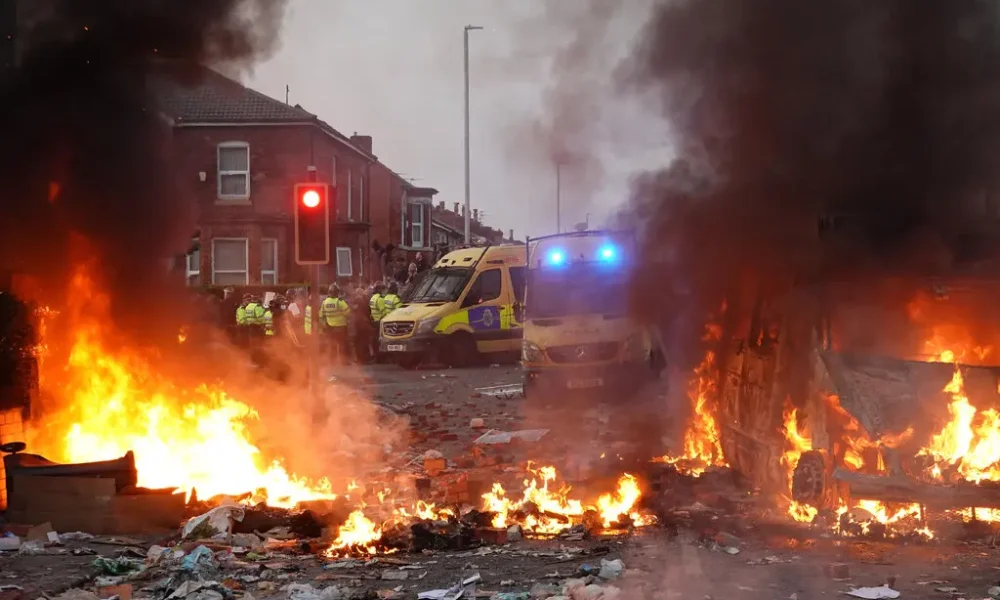Violent unrest has erupted in several towns and cities in Britain in recent days, and further disorder broke out on Saturday as far-right agitators gathered in demonstrations around the country.
The violence has been driven by online disinformation and extremist right-wing groups intent on creating disorder after a deadly knife attack on a children’s event in northwestern England, experts said.
A range of far-right factions and individuals, including neo-Nazis, violent soccer fans and anti-Muslim campaigners, have promoted and taken part in the unrest, which has also been stoked by online influencers.
Prime Minister Keir Starmer has vowed to deploy additional police officers to crack down on the disorder. “This is not a protest that has got out of hand,” he said on Thursday. “It is a group of individuals who are absolutely bent on violence.”
Here is what we know about the unrest and some of those involved.
Where have riots taken place?
The first riot took place on Tuesday evening in Southport, a town in northwestern England, after a deadly stabbing attack the previous day at a children’s dance and yoga class. Three girls died of their injuries, and eight other children and two adults were wounded.
The suspect, Axel Rudakubana, was born in Britain, but in the hours after the attack, disinformation about his identity — including the false claim that he was an undocumented migrant — spread rapidly online. Far-right activists used messaging apps including Telegram and X to urge people to take to the streets.
Over 200 people descended on Southport on Tuesday night, many traveling by train from elsewhere in Britain, the police said. Rioters attacked a mosque, wounded more than 50 police officers and set vehicles alight.
On Wednesday night, another far-right demonstration brought clashes with the police in central London, leading to over 100 arrests. Smaller pockets of disorder broke out in Hartlepool, in northeastern England; in the city of Manchester; and in Aldershot, a town southeast of London.
On Friday night, Northumbria Police said its officers had been “subjected to serious violence” as far-right demonstrators set fires and attacked officers in Sunderland, a city in the northeast.
Saturday brought violent protests to cities including Hull, Leeds, Manchester, Nottingham and Stoke-on-Trent, as well as Belfast, Northern Ireland. In Liverpool, the police said more than 300 people had been involved in “violent disorder” on Saturday night, with businesses looted and two officers hospitalized.
The chair of the National Police Chiefs’ Council, Gavin Stephens, told BBC Radio on Friday that extra officers would be on Britain’s streets and that the police would use lessons learned from the 2011 London riots.
“We will have surge capacity in our intelligence, in our briefing and in the resources that are out in local communities,” he said. The organization has said that nearly 4,000 additional officers have been deployed to deter the violence.
Which groups are behind the unrest?
Several far-right groups have been at the riots or promoted them on social media. David Miles, a prominent member of Patriotic Alternative, a fascist group, shared photographs of himself in Southport, according to Hope Not Hate, a Britain-based advocacy group that researches extremist organizations.
Other far-right agitators spread information about the protest on social media, including British Movement, a neo-Nazi group. Images of the protests examined by Hope not Hate showed some people with Nazi tattoos.
After the disorder in Southport, the police said that supporters of the English Defence League had been involved. The riots have also attracted people linked to soccer violence, or hooliganism, which has long overlapped with nationalist movements in Britain.
A group of people point and throw a traffic cone at a police officer who bends over to get out of the way.
A crowd clashed with the police after a vigil near the site of the stabbing attack in Southport on Tuesday.Credit…Richard McCarthy/Press Association, via Associated Press
Officials noted that not everyone at the demonstrations had far-right views. David Hanson, a cabinet minister, told LBC Radio on Friday: “Some might be caught up in the summer madness. Some might be people who’ve got genuine concerns.”
But, he warned, “If you are organising this now, we will be watching you.”
READ MORE FROM NEW YORK TIMES

